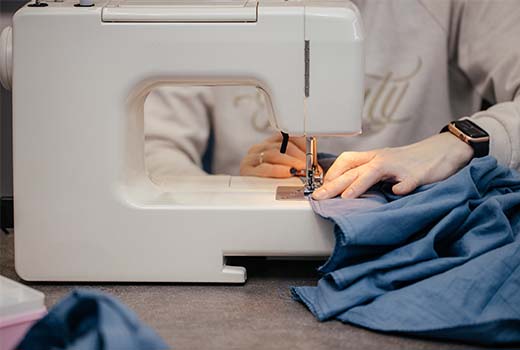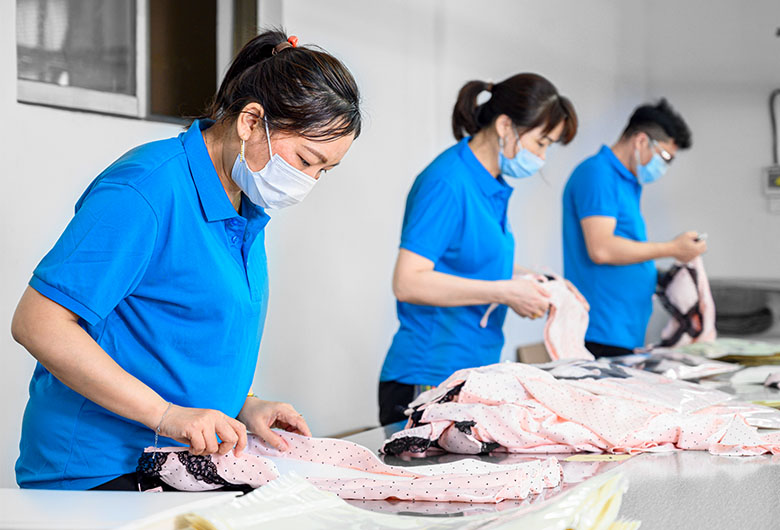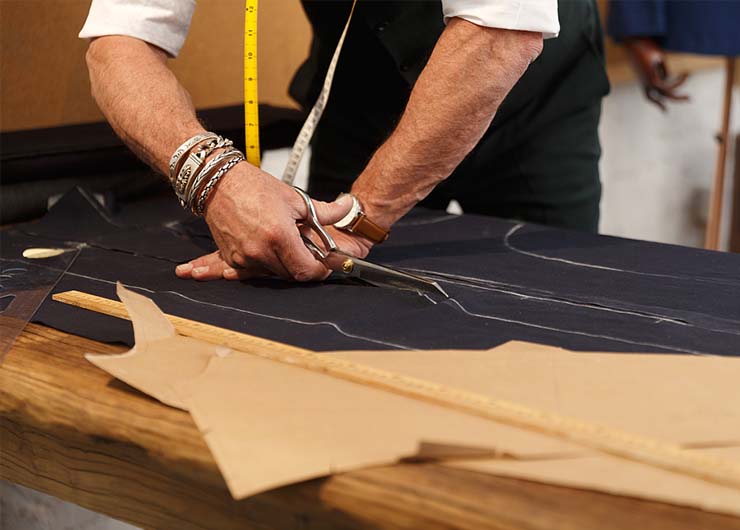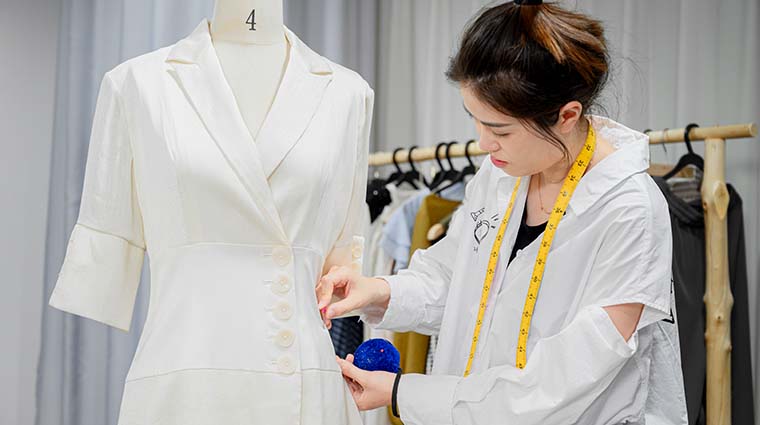衣服の製造は、デザイン、パターン作成、裁断、縫製、仕上げまで、複数の段階を経る複雑なプロセスです。 婦人服メーカー高品質で顧客の期待に応える製品を提供するためには、衣料品の製造プロセスを徹底的に理解することが重要です。このブログでは、衣料品の製造プロセスの概要を簡単に説明し、衣料品の製造プロセスを理解することの重要性について説明します。 ドレス製造, スカートメーカー、 または 大量注文のオーダーメイド服このガイドは、衣料品の製造プロセスに関する貴重な洞察を提供します。

デザインとパターンメイキング
衣服製造プロセスの第一段階は、デザインとパターン作成です。この段階では、デザインコンセプトを作成し、それを衣服の製造に使用できるパターンに変換します。 婦人服メーカーターゲット市場にアピールするユニークで革新的なデザインを作成できる強力なデザインチームを持つことが重要です。
1. デザインコンセプトの作成
デザインコンセプトは、衣服製造プロセスの最初のステップです。スタイル、色、生地など、衣服のビジョンを描き出すことが含まれます。デザインチームはクライアントと緊密に連携し、ニーズと好みを理解し、要件を満たすデザインを作り上げます。デザインコンセプトが確定すると、チームはパターンメイキングの段階に進みます。
2. デザインをパターンにする
パターンメイキングの段階では、衣服を製作するためのパターンを作成します。これは、デザインコンセプトを2Dパターンに変換し、生地を裁断するためのものです。パターンメーカーは、衣服のサイズと形状を考慮しながら、専用のソフトウェアを使用してパターンを作成します。パターンが作成されると、正しくフィットすることを確認するためにテストと調整が行われます。
3. パターンのグレーディングとマーキング
パターングレーディングとは、様々な体型に対応するために、異なるサイズのパターンを作成することです。これは衣服の製造工程において重要なステップであり、様々な体型に衣服が正しくフィットすることを保証します。グレーディングされたパターンには、生地を裁断して縫製する位置を示すノッチと記号が付けられます。これは衣服が正しく組み立てられることを保証するため、工程における重要なステップです。

生地の選択と準備
衣服の成功には、適切な生地を選ぶことが不可欠です。生地は衣服のデザインと用途に基づいて選択する必要があります。 婦人服メーカーそれぞれの衣服に適した生地を選ぶためには、さまざまな生地とその特性をよく理解することが重要です。
1. 衣服のデザインと目的に合った生地を選ぶ
生地は、衣服のデザインと用途に基づいて選ぶ必要があります。例えば、夏用のドレスであれば、綿や麻などの軽量で通気性のある生地が適しています。フォーマルなドレスであれば、シルクやサテンなどの構造的な生地が適しています。また、衣服の色や柄、そしてターゲット市場を考慮して生地を選ぶことも重要です。
2. 生地の準備と前処理
生地を選んだら、衣服の製作に使用する前に、生地を準備し、前処理する必要があります。これには、生地を洗浄、乾燥、アイロンがけして汚れ、ホコリ、シワを取り除く作業が含まれます。また、耐水性や難燃性などの特性を高めるために、化学薬品で前処理する必要がある場合もあります。これは、生地を清潔に保ち、衣服の製作に適した状態にするため、工程において重要なステップです。
したがって、適切な生地を選び、適切に準備することが、衣服の成功にとって非常に重要です。 婦人服メーカーそれぞれの衣服に最適な生地を選ぶには、様々な生地とその特性をよく理解することが重要です。適切な生地を選び、適切に準備することで、お客様の期待に応える高品質な衣服をお届けすることができます。

切断
裁断工程は、パターンに沿って生地を裁断する工程です。裁断工程でミスをすると、衣服のフィット感が悪くなる可能性があるため、衣服製造工程において非常に重要な工程です。 婦人服メーカー生地を正確かつ効率的に裁断できる熟練した作業員がいることが重要です。
1. 生地の上にパターンピースを配置する
布を裁断する前に、型紙を布の上に並べる必要があります。これは、無駄を最小限に抑え、布が正しい方向に裁断されるように、型紙を布の上に並べる作業です。その後、型紙をピンで留めて、裁断中に固定します。
2. 型紙に沿って布を切る
型紙を布の上に置いたら、型紙に沿って布を裁断します。ハサミやロータリーカッターなどの専用の裁断器具を使い、型紙の端に沿って布を切ります。布は、組み立て時に正しくフィットするよう、慎重かつ正確に裁断されます。

縫い
縫製工程は、生地を組み立てて衣服を作り上げます。これは衣服の製造工程において非常に重要な段階であり、衣服の品質と耐久性を左右します。 婦人服メーカー生地の断片を正確かつ効率的に縫い合わせることができる熟練した作業員がいることが重要です。
1. 衣服の組み立て
衣服の組み立ては、パターンに従って布片を縫い合わせる作業です。直線縫い、ジグザグ縫い、オーバーロック縫いなど、様々な縫製技術が用いられます。布片は丁寧かつ正確に縫い合わされ、衣服がぴったりとフィットし、着心地が良くなるように作られています。
2. さまざまな縫製技術
縫製工程では、様々な種類の縫製技術が用いられます。使用する縫製技術は、生地の種類や衣服のデザインによって異なります。例えば、強度と耐久性が求められる縫い目には直線縫いが使用され、柔軟性と伸縮性が求められる縫い目にはジグザグ縫いが使用されます。また、生地の端を仕上げてほつれを防ぐには、オーバーロック縫いが用いられます。
3. 縫製工程における品質管理
品質管理は縫製工程において重要な部分です。生地片と完成した衣服に欠陥や不具合がないか確認し、問題が見つかった場合は、次の製造工程に進む前に修正します。これにより、衣服は高品質で、お客様の期待に応えることが保証されます。
として 婦人服メーカー生地を正確かつ効率的に縫い合わせることができる熟練した作業員がいることが重要です。様々な縫製技術を駆使し、品質管理体制を整備することで、お客様の期待に応える高品質な衣類をお届けすることができます。信頼できる縫製メーカーをお探しなら、 ドレス製造, スカートメーカー、 または 大量注文のオーダーメイド服熟練した作業員を擁し、縫製工程で品質管理措置を実施しているメーカーを選ぶようにしてください。

仕上げ
仕上げ工程は、衣服が完成し、販売準備が整う段階です。これには、余分な糸や布地のトリミング、衣服のプレスとアイロンがけ、ラベルやタグの取り付けなどが含まれます。 婦人服メーカー、 仕上げ工程を正確かつ効率的に完了できる熟練した作業員がいることが重要です。
1. 余分な糸や布地を切り取る
衣服を販売する前に、余分な糸や布地を裁断する必要があります。これは、はさみや糸切り器を使って、ほつれた糸やはみ出ている余分な布地を取り除く作業です。これは、衣服をきれいに整えるための重要な工程です。
2. プレスとアイロン
余分な糸と布地を裁断したら、衣服をアイロンでプレスし、しわや折り目を取り除きます。これは、衣服をプロフェッショナルな仕上がりにし、すぐに着用できるようにするための重要なステップです。
3. ラベルとタグの追加
仕上げ工程の最終段階は、衣服にラベルとタグを付けることです。サイズ、お手入れ方法、ブランド名などが記載されたラベルを付ける作業です。これは、衣服に適切なラベルが貼られ、販売準備が整っていることを保証するため、工程において重要なステップです。

品質管理
品質管理は衣料品の製造工程において不可欠な要素です。 婦人服メーカー衣服が高品質で、顧客の期待に応えるものであることを確認することが重要です。これには、完成した衣服の欠陥検査や、フィット感、快適性、耐久性のテストが含まれます。
1. 完成した衣服の欠陥検査
衣服をお客様に出荷する前に、欠陥がないか検査する必要があります。糸のほつれ、ボタンの紛失、縫製の不備など、衣服に問題がないか確認します。見つかった欠陥はすべて、お客様に出荷される前に修正されます。これは、衣服が高品質でお客様の期待に応えるものであることを保証するため、プロセスにおける重要なステップです。
2. フィット感、快適性、耐久性のテスト
衣服の欠陥を検査するだけでなく、フィット感、快適性、耐久性をテストすることも重要です。これは、衣服を試着し、正しくフィットし、着心地が良いことを確認することを意味します。また、衣服は洗濯と着用を何度も繰り返し、長期間の使用に耐えられるかを確認する耐久性テストも行われます。これは、衣服が高品質であり、顧客の期待に応えるものであることを保証するため、プロセスにおける重要なステップです。

梱包と配送
衣料品製造工程の最終段階は、小売業者や顧客への衣料品の梱包と出荷です。これは、衣料品が目的地に良好な状態で到着することを保証するため、出荷に向けて衣料品を梱包し準備することを意味します。 婦人服メーカー衣類が時間通りに良好な状態で配達されることを保証するために、信頼できる配送プロセスを確立することが重要です。
1. 衣類の梱包と発送準備
衣類を発送する前に、梱包して発送準備を行う必要があります。これは、衣類をきれいに折りたたみ、輸送中に保護するための梱包材に詰めることを意味します。梱包材は、衣類のサイズや種類に応じて、箱、袋、封筒などを使用します。衣類が目的地に良好な状態で届くよう、梱包は頑丈で安全なものでなければなりません。
2. 衣服の発送
衣類が梱包され、発送準備が整ったら、小売店または顧客への発送準備が完了します。衣類が時間通りに良好な状態で届けられるよう、信頼できる配送サービスを利用する必要があります。配送業者は、顧客が配送の進捗状況を追跡できるよう、追跡情報を提供する必要があります。
結論
結論として、 婦人服メーカー衣料品の製造工程を深く理解し、品質管理と細部へのこだわりを徹底することが重要です。そうすることで、お客様の期待に応える高品質な衣料品をお届けすることができます。




